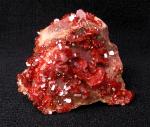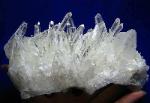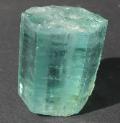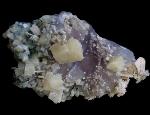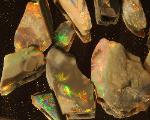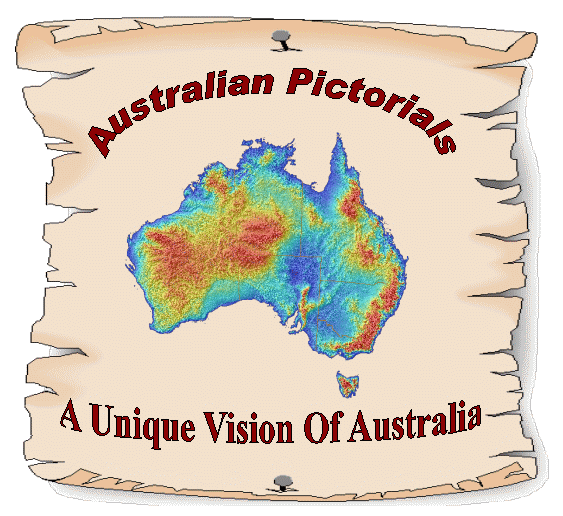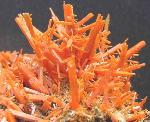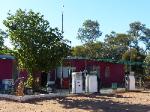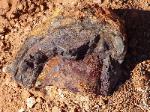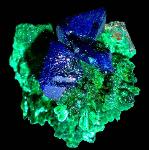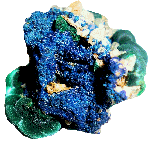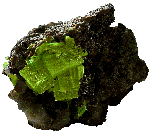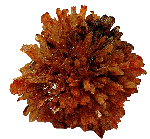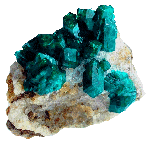
| Faceted Gems - The gems beauty is revealed from a rough stone. |

Malachite - Polished and set
into a hand made silver setting.
into a hand made silver setting.

Free Form Silver
There are no limits when
designing jewelry.
There are no limits when
designing jewelry.

Ameythst. - A piece of rough
geode set in silver.
geode set in silver.

Amber - This fossilized tree
resin is millions of years old.
resin is millions of years old.

Soldering Silver. Making a
ring from sterling silver.
ring from sterling silver.

| Cabachons The cabachon design is the most widely used in jewelry. |

Making Jewelry Combining
jewelry and gems is an age
old art.
jewelry and gems is an age
old art.

Gemstones
Once polished they can be
set into jewelry.
Once polished they can be
set into jewelry.



Minerals formed by nature
have a beauty of their own.
have a beauty of their own.

Agate still contained in lava
rock from Agate Creek in Qld.
rock from Agate Creek in Qld.











| 85.77 ct Blue Topaz from Africa. |
| 140.80 ct Imperial Topaz from Brazil. |

Minerals Natural Beauty
| Vanadinite. Mibladen, Morocco |
| Sulphur with Aragonite Girgenti, Agrigento Province, Sicily, Italy |
| Schorl on Feldspar matrix. Brazil |
Quartz Crystals Brazil





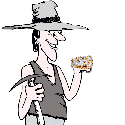
| Petrified Wood Chinchilla - Queensland |
Agate - Argentina






| Agate - From Agate Creek Australia. |









| To Join The Message Board just click the above banner please. |







| Welcome to Lapidary World! Incorporating The Australian Gem Club Directory We have a vast data base of information about lapidary and associated hobbies including: Gemstones, faceting, rock collecting, maps, photos, metal detecting, jewelry making, stories, projects, club directories, equipment and much more. Search through the various index links to take you to areas of interest. Lapidary World is proudly a non-profit Australian achievement website!
|
Our Field Trip Adventure
By John Boom
We left Coffs Harbour some 3 weeks ago and decided to visit
some of the various well-known gemstone fields in Queensland.
I've written this for others that may have an interest in a similar
trip.
Marlborough - Chrysoprase
After leaving Coffs Harbour we headed up through Biggenden
and had a look around that area but found the gold mine areas
still active without access. So we then made our way up through
Rockhampton and went to Marlborough to look for some
Chrysoprase. To get to the area we went down the old
Marlborough Road and turned left at Currunburra Road. We
searched the creek areas and found the odd white piece but
nothing with any apple greens. We went further past
Marlborough Station and again found some white pieces but
nothing nice to speak of. But we had an enjoyable time in this
area. There are perhaps better areas but most likely on private
property.
We’ve never been this far into Queensland before so this trip
was really just a bit of an adventure for us and at the same time
it gave us the opportunity to decide on places to go again in the
future. Basically eliminating areas of no interest.
Mt Hay – Thunder Eggs - Ryolite
After this we headed back into Rockhampton and made our way
to Mt Hay in the hope of finding some Thunder Eggs and
Ryolite. This was a disappointment as we would have stayed at
their caravan park for no doubt some days but when we got
there the fossicking area had been apparently closed for the
last five years due to public liability reasons we were told. And
now all that remains is basically a rock shop, caravan park and
an area where they just dump some material you pay $12.00
per person to look through. It’s just not the same as fossicking
for it yourself so we left that area a short time later and made
our way toward the Anakie Sapphire fields. It would be hoped
the owners will one-day turn this situation around.
Sapphire Field Area Photos
By John Boom
We left Coffs Harbour some 3 weeks ago and decided to visit
some of the various well-known gemstone fields in Queensland.
I've written this for others that may have an interest in a similar
trip.
Marlborough - Chrysoprase
After leaving Coffs Harbour we headed up through Biggenden
and had a look around that area but found the gold mine areas
still active without access. So we then made our way up through
Rockhampton and went to Marlborough to look for some
Chrysoprase. To get to the area we went down the old
Marlborough Road and turned left at Currunburra Road. We
searched the creek areas and found the odd white piece but
nothing with any apple greens. We went further past
Marlborough Station and again found some white pieces but
nothing nice to speak of. But we had an enjoyable time in this
area. There are perhaps better areas but most likely on private
property.
We’ve never been this far into Queensland before so this trip
was really just a bit of an adventure for us and at the same time
it gave us the opportunity to decide on places to go again in the
future. Basically eliminating areas of no interest.
Mt Hay – Thunder Eggs - Ryolite
After this we headed back into Rockhampton and made our way
to Mt Hay in the hope of finding some Thunder Eggs and
Ryolite. This was a disappointment as we would have stayed at
their caravan park for no doubt some days but when we got
there the fossicking area had been apparently closed for the
last five years due to public liability reasons we were told. And
now all that remains is basically a rock shop, caravan park and
an area where they just dump some material you pay $12.00
per person to look through. It’s just not the same as fossicking
for it yourself so we left that area a short time later and made
our way toward the Anakie Sapphire fields. It would be hoped
the owners will one-day turn this situation around.
Sapphire Field Area Photos


Anakie Sapphire Fields - Sapphires
We stayed at the Anakie caravan park on our first night and
did some digging at the Willows and Sapphire areas for a
couple of days. We stayed at other parks in the sapphire
areas as well. We found these areas to be of future interest
and will
no doubt go back there and spend a week or more there.
These type of areas you need to spend substantial time
because it takes time to dig decent holes and get established
in the areas you want to dig in. The Willows and Sapphire
areas have some shallow areas where to dig and sieve.
Tools Needed:
One good large pick and long handle shovel.
One quarter and eighth inch sieve. I used 500 mm round ones
suspended from a tripod as you can see in the photos. You
will need water and a drum for the final sieving to see if you
have anything in your sieve. You could make your own sieves
as well. A Hessian bag on a table is good to tip the final sieve
lot onto to see if you’ve found anything.
All tools can be purchased at Sapphire if required. No power
tools are permitted on any of the fields unless you have a
lease and then only limited power tools are permitted.
Although we didn’t find any sapphires on this trip we feel these
areas are well worth spending a few weeks holiday on. You
need to put in the hard work and plenty of time.
The sapphires are located in the old wash, which is made up
of small to very large pebbles, sand, dirt and clay. It’s very,
very hard work digging. The depth varies from field areas from
near the surface to around 40 foot deep around the Rubyvale
fields. All the fields are located near each another so you can
try different areas if you’re interested. But even the surface
areas are still hard work though. You could reach most areas
by car but a 4x4 would be better for going down some tracks.
Area Photos Below
We stayed at the Anakie caravan park on our first night and
did some digging at the Willows and Sapphire areas for a
couple of days. We stayed at other parks in the sapphire
areas as well. We found these areas to be of future interest
and will
no doubt go back there and spend a week or more there.
These type of areas you need to spend substantial time
because it takes time to dig decent holes and get established
in the areas you want to dig in. The Willows and Sapphire
areas have some shallow areas where to dig and sieve.
Tools Needed:
One good large pick and long handle shovel.
One quarter and eighth inch sieve. I used 500 mm round ones
suspended from a tripod as you can see in the photos. You
will need water and a drum for the final sieving to see if you
have anything in your sieve. You could make your own sieves
as well. A Hessian bag on a table is good to tip the final sieve
lot onto to see if you’ve found anything.
All tools can be purchased at Sapphire if required. No power
tools are permitted on any of the fields unless you have a
lease and then only limited power tools are permitted.
Although we didn’t find any sapphires on this trip we feel these
areas are well worth spending a few weeks holiday on. You
need to put in the hard work and plenty of time.
The sapphires are located in the old wash, which is made up
of small to very large pebbles, sand, dirt and clay. It’s very,
very hard work digging. The depth varies from field areas from
near the surface to around 40 foot deep around the Rubyvale
fields. All the fields are located near each another so you can
try different areas if you’re interested. But even the surface
areas are still hard work though. You could reach most areas
by car but a 4x4 would be better for going down some tracks.
Area Photos Below
Agate Creek
After O’Briens Creek we made our way to Agate Creek in search
of Agates. You have to go over at least 120 kms of corrugated
dirt road from Georgetown to get there for a start. We stayed at
the Safari Camp at the end of the track to Agate Creek.
On the way to Agate Creek you’ll come to an intersection where
you can turn right to go to Cobbold Gorge around 7 klms down
that road. The road to Agate Creek is to the left as there is no
sign there to let you know that. Take enough food, water and fuel
for your period of stay. There are no shops in Agate Creek.
The closest town to Agate Creek is Forsayth over 70 klms away.
Then Georgetown after that. Fuel and supplies can be purchased
at both places at higher than city prices. Agate creek is a magic
and mystical place well worth spending a whole holiday period if
you like nature and getting back to the basics.
Wild brumbies roam everywhere, the odd wild pig runs here and
there. With an abundance of wildlife it’s a great place for a real
camping experience for the whole family. Again only basic
facilities with showers and toilets and no power. There's drinking
water from a tap at the toilet block.
We had seats around the campfire every night of our stay with
host Laurie Baron keeping every night interesting. It’s a
fascinating place if you like bush walking and Aboriginal cave
paintings not far from the camp in the hills. Cattle roam free in
these areas outside the camp as do most outback Queensland
areas so be watchful on all the roads when you travel.
There are areas like Crystal Hill where the agate actually lines the
tracks. There is plenty of specimen agate to be found there still
but for the good stuff you’ll need to dig with a pick and a shovel.
There are many areas to search and the agate is found in areas
specific in that the agate is found in the volcanic flow areas.
You’ll need to have a fossickers licence before you get there
which can be purchased from a mining registrar at Georgetown.
(Around $8.20 for a family for one month or dearer for a longer
period.) You can again only use hand tools.
I found that the biggest percentage of the agate you’ll find is
quartz filled and many with geode crystals. Agate can also be
found in the creeks around the general fossicking areas here and
there as well.
If you stay at the Agate Creek Safari Camp (I can highly
recommend it) you can actually walk up the hill in a few locations
and dig for agates surrounding the camp area. You can contact
the camp manager: Laurie Baron on: (07) 4062 5574 or try his
mobile on: 0409 463 192 to make an advance booking and just to
make sure the camp is open as this area can only be accessed in
the dry weather periods.
Usual periods are between April till September but ring before you
go just to make sure. Laurie has a heliport area and phone for
any absolute emergency situation. You can have a campfire for
your personal use there if you like. If you have children they can
easily find some nice colored agate chips and pieces everywhere
around the areas on the ground surface. They will love the area.
Tools needed: Large pick, long handle shovel and small hand
pick. A satellite phone is always good if you have one on a trip
such as this. Always carry water with you and matches in case
you get lost so you can light a signal fire in a safe manner.
A four-wheel drive vehicle is best in this area or if you can take a
four-wheel motorbike to get around the tracks would be just as
good. Make sure your vehicle is in top condition as this is an
isolated area.
Check under "Australian Pictorials" for more field trip
stories.
Agate Creek Photos Below.
After O’Briens Creek we made our way to Agate Creek in search
of Agates. You have to go over at least 120 kms of corrugated
dirt road from Georgetown to get there for a start. We stayed at
the Safari Camp at the end of the track to Agate Creek.
On the way to Agate Creek you’ll come to an intersection where
you can turn right to go to Cobbold Gorge around 7 klms down
that road. The road to Agate Creek is to the left as there is no
sign there to let you know that. Take enough food, water and fuel
for your period of stay. There are no shops in Agate Creek.
The closest town to Agate Creek is Forsayth over 70 klms away.
Then Georgetown after that. Fuel and supplies can be purchased
at both places at higher than city prices. Agate creek is a magic
and mystical place well worth spending a whole holiday period if
you like nature and getting back to the basics.
Wild brumbies roam everywhere, the odd wild pig runs here and
there. With an abundance of wildlife it’s a great place for a real
camping experience for the whole family. Again only basic
facilities with showers and toilets and no power. There's drinking
water from a tap at the toilet block.
We had seats around the campfire every night of our stay with
host Laurie Baron keeping every night interesting. It’s a
fascinating place if you like bush walking and Aboriginal cave
paintings not far from the camp in the hills. Cattle roam free in
these areas outside the camp as do most outback Queensland
areas so be watchful on all the roads when you travel.
There are areas like Crystal Hill where the agate actually lines the
tracks. There is plenty of specimen agate to be found there still
but for the good stuff you’ll need to dig with a pick and a shovel.
There are many areas to search and the agate is found in areas
specific in that the agate is found in the volcanic flow areas.
You’ll need to have a fossickers licence before you get there
which can be purchased from a mining registrar at Georgetown.
(Around $8.20 for a family for one month or dearer for a longer
period.) You can again only use hand tools.
I found that the biggest percentage of the agate you’ll find is
quartz filled and many with geode crystals. Agate can also be
found in the creeks around the general fossicking areas here and
there as well.
If you stay at the Agate Creek Safari Camp (I can highly
recommend it) you can actually walk up the hill in a few locations
and dig for agates surrounding the camp area. You can contact
the camp manager: Laurie Baron on: (07) 4062 5574 or try his
mobile on: 0409 463 192 to make an advance booking and just to
make sure the camp is open as this area can only be accessed in
the dry weather periods.
Usual periods are between April till September but ring before you
go just to make sure. Laurie has a heliport area and phone for
any absolute emergency situation. You can have a campfire for
your personal use there if you like. If you have children they can
easily find some nice colored agate chips and pieces everywhere
around the areas on the ground surface. They will love the area.
Tools needed: Large pick, long handle shovel and small hand
pick. A satellite phone is always good if you have one on a trip
such as this. Always carry water with you and matches in case
you get lost so you can light a signal fire in a safe manner.
A four-wheel drive vehicle is best in this area or if you can take a
four-wheel motorbike to get around the tracks would be just as
good. Make sure your vehicle is in top condition as this is an
isolated area.
Check under "Australian Pictorials" for more field trip
stories.
Agate Creek Photos Below.
Alpha - Petrified Wood
We went to a town called Alpha and stayed there the night at the
Caravan park because we heard there was some petrified wood
in the area. The park owners were fairly new and also filled us in
on where to find the wood.
Directions:
Just before you come into Alpha you turn left into Tambo Road
just before the large bridge that enters the town. The very first
turn left again will take you to a roadside quarry area 1 km down
that road on the right hand side. We found about a bucket of
petrified wood between us from small tumbling to cutting size.
You can also find some tumbling size pieces in the creek under
the bridge near the town as well. But the quarry area is the main
source area.
Clermont – Gold Detecting
After that area we spent a couple of days in the Clermont area
and did a little metal detecting. In the caravan park you’ll also find
the Clermont detector shop. These people are friendly and give
advice on the best places to detect in the area.
You can also purchase a Fossicking Kit from them, which
includes maps of the area etc. I think it was about $5.50 for two
days and more if you stay longer. This is different than the
fossickers license which is required throughout Queensland. The
fossickers license can also be purchased from them if required.
The Clermont detector shop sells new and used detectors and
also hires them out.
We didn’t stay long enough to give the areas any justice and
basically just had a look around for now and will no doubt go
back there for an extended longer stay. This caravan park has all
facilities. A four wheel drive vehicle is best in this area or if you
can take a four wheel motorbike to get around the tracks would
be just as good.
Area Photos
We went to a town called Alpha and stayed there the night at the
Caravan park because we heard there was some petrified wood
in the area. The park owners were fairly new and also filled us in
on where to find the wood.
Directions:
Just before you come into Alpha you turn left into Tambo Road
just before the large bridge that enters the town. The very first
turn left again will take you to a roadside quarry area 1 km down
that road on the right hand side. We found about a bucket of
petrified wood between us from small tumbling to cutting size.
You can also find some tumbling size pieces in the creek under
the bridge near the town as well. But the quarry area is the main
source area.
Clermont – Gold Detecting
After that area we spent a couple of days in the Clermont area
and did a little metal detecting. In the caravan park you’ll also find
the Clermont detector shop. These people are friendly and give
advice on the best places to detect in the area.
You can also purchase a Fossicking Kit from them, which
includes maps of the area etc. I think it was about $5.50 for two
days and more if you stay longer. This is different than the
fossickers license which is required throughout Queensland. The
fossickers license can also be purchased from them if required.
The Clermont detector shop sells new and used detectors and
also hires them out.
We didn’t stay long enough to give the areas any justice and
basically just had a look around for now and will no doubt go
back there for an extended longer stay. This caravan park has all
facilities. A four wheel drive vehicle is best in this area or if you
can take a four wheel motorbike to get around the tracks would
be just as good.
Area Photos

O'Briens Creek
Then it was off to Mount Surprise to look for Topaz. We stayed at
the Mount Surprise Gem Caravan Park in the nice selection of
gems on display as well as live birds and those miniature ponies.
The next day we headed off to O’Briens Creek which is the actual
fossicking area for the Topaz. The caravan park there doesn’t
have power only showers and toilets. You can get some drinking
water from a tap adjoining the toilet block. It’s all very basic but a
most beautiful area. This is an area well worth spending some
weeks at for a holiday.
You have to travel approx. 35 kms down a corrugated dirt road
from Mount Surprise to get there. It’s around a 2 klm drive from
this park to most of the fossicking areas.
I suggest you bring enough food and water for the period you
wish to stay before getting there. We stayed here for a few days
and found some topaz as per the photo.
You can use the same tools as per sapphires but you’ll only need
a quarter inch sieve here. You can dry sieve but for best results it
pays to dip the final sieve after dry sieving into water. It just shows
the topaz up better. Digging here is a little easier but it’s still hard
work as you can see by the hole we were in on the photos.
Take some bread with you and feed the parrots in the caravan
park and you’ll find them all over you, as they were very tame.
The park managers were very friendly and helpful with advice on
the best places to search. You can have a campfire for your
personal use there if you like. A four wheel drive vehicle is best in
this area or if you can take a four wheel motorbike to get around
the tracks would be just as good.
O'Briens Creek Area Photos
Then it was off to Mount Surprise to look for Topaz. We stayed at
the Mount Surprise Gem Caravan Park in the nice selection of
gems on display as well as live birds and those miniature ponies.
The next day we headed off to O’Briens Creek which is the actual
fossicking area for the Topaz. The caravan park there doesn’t
have power only showers and toilets. You can get some drinking
water from a tap adjoining the toilet block. It’s all very basic but a
most beautiful area. This is an area well worth spending some
weeks at for a holiday.
You have to travel approx. 35 kms down a corrugated dirt road
from Mount Surprise to get there. It’s around a 2 klm drive from
this park to most of the fossicking areas.
I suggest you bring enough food and water for the period you
wish to stay before getting there. We stayed here for a few days
and found some topaz as per the photo.
You can use the same tools as per sapphires but you’ll only need
a quarter inch sieve here. You can dry sieve but for best results it
pays to dip the final sieve after dry sieving into water. It just shows
the topaz up better. Digging here is a little easier but it’s still hard
work as you can see by the hole we were in on the photos.
Take some bread with you and feed the parrots in the caravan
park and you’ll find them all over you, as they were very tame.
The park managers were very friendly and helpful with advice on
the best places to search. You can have a campfire for your
personal use there if you like. A four wheel drive vehicle is best in
this area or if you can take a four wheel motorbike to get around
the tracks would be just as good.
O'Briens Creek Area Photos

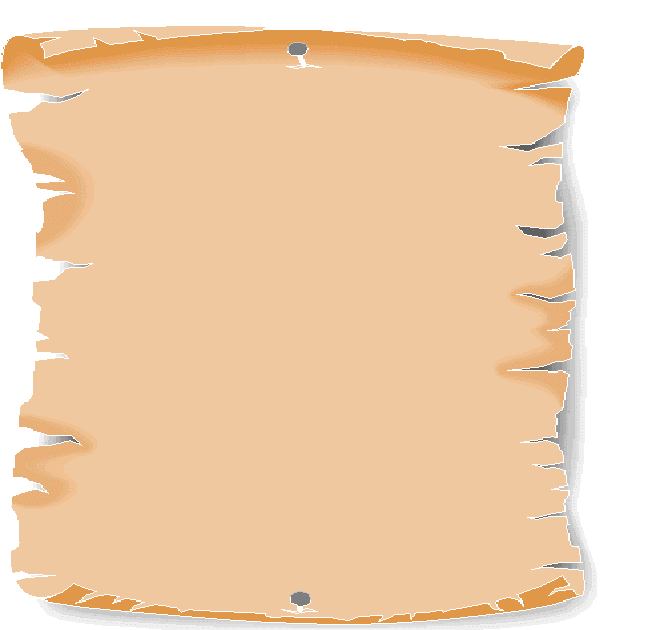
Yowah - Queensland
Yowah is a small opal mining town where people still mine and
dig for Yowah nuts which are very different than the other
normal style opal in other parts of Australia. The opal forms
mainly in nut like shapes of ironstone matrix opal with spider like
veins of opal. Sometimes thicker pieces of opal may be found
as well but that's not as common as its nearly always contained
in the ironstone.
Here you must either cut or break the rocks before you can see
if there's any colour within each piece. Sometimes you can get
an indication from the outside of the rock. Most of the serious
miners do open cut mining at this location where they use
excavators to dig down to the ironstone level if they're lucky
enough to find it that is. The bulk of the opal found isn't usually
as valuable as each stone is more like a picture stone with fine
veins of coloured opal running through the ironstone. Greens
are the most common colours found.
The town if you can call it that has a small general store and a
caravan park. But still you can manage there quiet well at the
caravan park with all facilities. There a host of dealers selling
their opals direct to the public unless you want to try your luck
and look through the fossicking area. It really is a machinery
game at this location and you need to remember not to stray
onto mining leases in the area.
YOWAH PICTORIAL CLICK HERE
Yowah is a small opal mining town where people still mine and
dig for Yowah nuts which are very different than the other
normal style opal in other parts of Australia. The opal forms
mainly in nut like shapes of ironstone matrix opal with spider like
veins of opal. Sometimes thicker pieces of opal may be found
as well but that's not as common as its nearly always contained
in the ironstone.
Here you must either cut or break the rocks before you can see
if there's any colour within each piece. Sometimes you can get
an indication from the outside of the rock. Most of the serious
miners do open cut mining at this location where they use
excavators to dig down to the ironstone level if they're lucky
enough to find it that is. The bulk of the opal found isn't usually
as valuable as each stone is more like a picture stone with fine
veins of coloured opal running through the ironstone. Greens
are the most common colours found.
The town if you can call it that has a small general store and a
caravan park. But still you can manage there quiet well at the
caravan park with all facilities. There a host of dealers selling
their opals direct to the public unless you want to try your luck
and look through the fossicking area. It really is a machinery
game at this location and you need to remember not to stray
onto mining leases in the area.
YOWAH PICTORIAL CLICK HERE
The Adventures Of Johnny Rocks - CLICK HERE!
| Petrified Wood Logs Outside The Emerald Town Hall. |
| Big Pick, Sieve & Shovel Outside The Sapphire Caravan Park |
| Shallow Digging By Hand. |
| Deeper Digging By Hand. |
| Deep Shaft Lease Digging At Rubyvale. |
| Yowah Opal Field Photos |
| Alpha Quarry Photo |
| Sieves & Tripod. |
| Sieving for Topaz and what we found. |
| Feeding my wife to the birds at O'Briens Creek Caravan Park. |
| Miniature ponies at Mount Surprise Caravan Park |
| Entrance To The Safari Camp. (Caravan Park Area) |
| Agate on the tracks. |
| Agate To Be Found At The Top Of This Hill Just Next To The Camp. |
| Typical Yowah Nuts Most Have No Opal |
| Fossils |
| Opal |
| Opal |
| Sapphires |

| Checkout my Australian Pictorials website which features nearly every town in Australia. Just click on the banner above to see all these towns in pictures. Also checkout the mining town areas as well! |

Expressions of interest in buying this website are now being
taken. Submit your offer to: admin@search-the-world.com
taken. Submit your offer to: admin@search-the-world.com

| Post anything to do with Lapidary and events on our Lapidaryworld Facebook page. |
| Post anything to do with Lapidary, events, videos, photos on our Lapidaryworld Facebook page. |














































